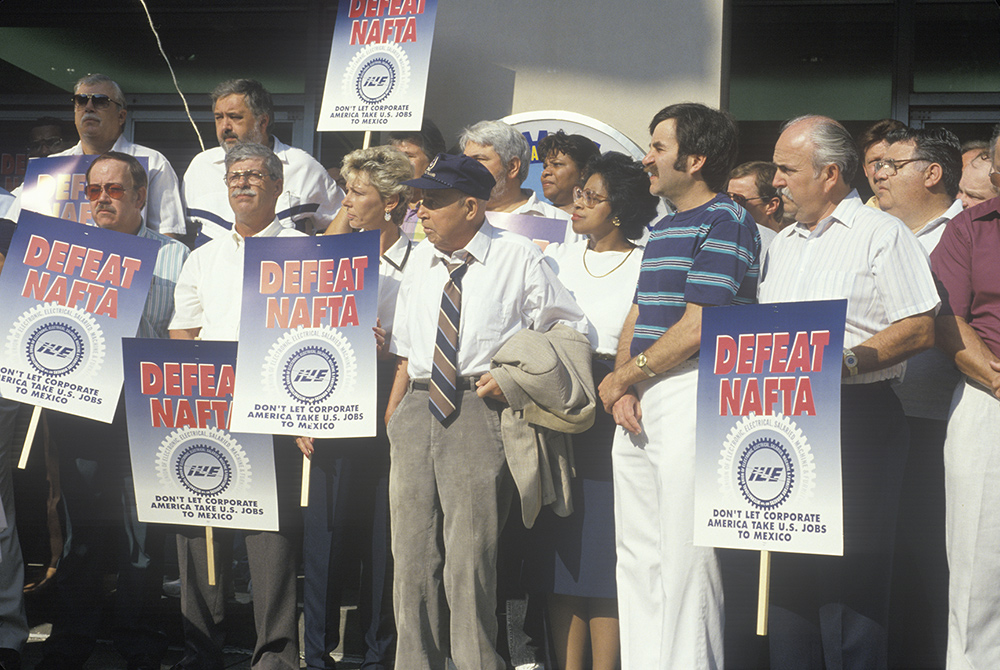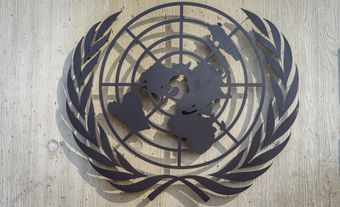The North American Free Trade Agreement (NAFTA) was an economic free trade agreement between Canada, the United States and Mexico. Designed to eliminate all trade and investment barriers between the three countries, the free trade agreement came into force on 1 January 1994. In addition to being one of the most ambitious trade agreements in history, NAFTA also created the world’s largest free trade area. It brought together two wealthy, developed countries (Canada and the United States) with a less developed state (Mexico). The agreement built on the earlier Canada-US Free Trade Agreement (CUSFTA), which came into effect on 1 January 1989. After NAFTA was signed, trade and investment relations between the three countries expanded rapidly, but political co-operation remained weak. NAFTA continued to be controversial, particularly in the United States. In 2017, US president Donald Trump threatened to renegotiate or cancel the deal. More than a year of negotiations produced a revised version of NAFTA called the Canada-United States-Mexico Agreement (CUSMA). CUSMA came into effect on 1 July 2020.

Why Was NAFTA Created?
Several political and economic factors over the course of the 1980s and into the 1990s led to the creation of NAFTA. The idea of a North American free trade area was raised by
Ronald Reagan in November 1979 when he announced his candidacy for the presidency. Both Canada (under Prime Minister Pierre
Trudeau) and Mexico (led by President José López Portillo) were deeply wary of US dominance and showed no interest in such a deal. However, in 1984, a change of government in Canada, with the election of Progressive
Conservative Prime Minister Brian
Mulroney, led to the negotiation of the CUSFTA.
In Canada, there was strong opposition to the CUSFTA within the Liberal and New Democratic parties and among the general public. In the United States, however, opposition from labour groups and the population at large was limited.
The move to bring in Mexico to create a North American free trade area was much more controversial. In 1981–82, Mexico experienced a debt crisis, during which time the country’s foreign debt exceeded their ability to pay it back. Following the crisis, leaders from Mexico’s dominant party, the Institutional Revolutionary Party (PRI), began to seek alternatives to the country’s nationalist economic model, adopted following the revolution of 1910–20. With pressure from the International Monetary Fund and World Bank, Mexican politicians began to open up their economy, and joined the General Agreement on Tariffs and Trade (GATT) — an international trade agreement originally signed in 1947 — in 1986. However, international investors were still skeptical about the stability of the Mexican economy and its long-term commitment to liberal economic policies. PRI president Carlos Salinas de Gortari, who came to power in 1988 in an election that was widely viewed as fraudulent, travelled to Europe in 1990 to deliver the message that Mexico had changed. However, European states and investors showed little interest in the Mexican market.
In response, Salinas, with his closest advisors, decided to approach US president George H.W. Bush to formally propose a free trade agreement with the United States. Salinas hoped not only to attract new investment but to legitimize his party’s rule, which had been undermined by the economic crisis and the events of the 1988 election. The proposed deal complemented the trade objectives of the Bush administration. Trade talks in the GATT had stalled, and European countries were increasingly trading amongst themselves and therefore less interested in trade with the United States. Therefore, a deal with Mexico (and Canada) was seen as a way of advancing US objectives for deeper levels of liberalization. Economist Paul Krugman argued that the US interest in the deal was as much political as it was economic, since the United States had an interest in shoring up the power of the ruling party in Mexico to prevent political instability on its southern border.
Canada was not initially part of the talks, but the Mulroney government eventually chose to join. The Canadian government and business leaders were somewhat reluctant to share their preferential access to the huge US market with Mexico and had little interest in the Mexican market because of the low level of Canada-Mexico trade. However, the Mulroney government eventually decided that it was better to be part of the negotiations and shape the outcome rather than face a deal between the United States and Mexico that might divert trade and investment away from Canada.
The Mexican leaders were told in no uncertain terms by the United States that their desire for free movement of labour within the North American region would not be permitted on the bargaining table. On the other hand, Mexico was able to resist US pressure to allow access to its oil resources in times of scarcity, an issue that Canada had bargained away in the Canada-US agreement. Canada continued to demand an exemption for its cultural industries from the terms of the agreement as it had in the CUSFTA, to permit the government to continue to support industries such as music, film and television through measures like content quotas and subsidies. After 14 intense months of negotiation between 1991 and 1992, the NAFTA agreement was signed by Bush, Salinas and Mulroney.
Before it could come into effect, the deal needed to be ratified. Shortly after the agreement was signed, Democrat Bill Clinton took office as President of the United States. Responding to pressures from supporters of his party, Clinton successfully pushed for the creation of two side accords, designed to protect the environment and labour rights, in order to push the deal through. These were separate agreements that required the three countries to enforce their own domestic legislation on these matters. Liberal Prime Minister Jean Chrétien, elected in 1993 on a platform that called for the renegotiation of NAFTA, backed down on his demands when Clinton refused to reopen talks. NAFTA was ratified by the legislatures in the three countries in 1993.

Critics in the United States and Canada argued that the negotiations were dominated by corporate interests, and that NAFTA would result in poor working conditions and low environmental standards as the three governments would compete for investment by lowering standards. Similarly, many feared losing high-paying manufacturing jobs in Canada and the United States to Mexico. By comparison, response among the Mexican public was limited, partly because many were disillusioned with the economic nationalist model that contributed to the debt crisis of the early 1980s. As well, the country was still ruled by a semi-authoritarian regime and the public had little access to independent information.
Content
The agreement was designed to reduce or eliminate trade and investment barriers between the three member states. Like the CUSFTA, NAFTA granted signatories “most-favoured nation” treatment, meaning each country could access the others’ markets without barriers such as high tariffs.
The objectives of the deal were laid out in its first chapter. These were to:
a) eliminate barriers to trade in, and facilitate the cross-border movement of, goods and services between the territories of the Parties;
b) promote conditions of fair competition in the free trade area;
c) increase substantially investment opportunities in the territories of the Parties;
d) provide adequate and effective protection and enforcement of intellectual property rights in each Party's territory;
e) create effective procedures for the implementation and application of this Agreement, for its joint administration and for the resolution of disputes; and
f) establish a framework for further trilateral, regional and multilateral cooperation to expand and enhance the benefits of this Agreement.
Canada and the United States had already lowered their tariffs dramatically, so the main impact of NAFTA’s removal of trade barriers was on Mexico. The final agreement included many elements of CUSFTA but extended that agreement in several key areas. For example, in the automobile sector, CUSFTA required that 50 per cent of a car’s parts be made in North America to qualify it for duty-free trade. Under NAFTA, that figure was increased to 62.5 per cent.
But perhaps the most important new element of NAFTA was the inclusion of an investor-state mechanism in chapter 11. Investor-state agreements permit a company in one country to take another member country to international arbitration based on the allegation that they’re treating that company unfairly.
In addition, the labour and environmental side accords represented a significant innovation, requiring that each partner respect its own laws. However, since they were located outside the main text of the agreement, they lacked effective enforcement mechanisms.
Unlike the European Union that came after it, NAFTA did not contain or promote political integration or moves toward supranational institutions like the European Parliament. NAFTA also became the model for most subsequent trade agreements pursued by the three partners with other countries.
NAFTA’s Impact
It is difficult to objectively evaluate the impact of NAFTA on the economies of the three countries and to distinguish between the impact of the trade agreement and other sources of economic change, such as globalization, the impact of China’s entry into the World Trade Organization, technological change and domestic political decisions of the respective countries. Discussion of NAFTA’s impact was highly polarized. Most federal government representatives from the three countries praised it as having a highly beneficial impact. As late as 2018, Global Affairs Canada held the position that “NAFTA has generated economic growth and rising standards of living for the people of all three member countries. By strengthening the rules and procedures governing trade and investment throughout the continent, NAFTA has proven to be a solid foundation for building Canada’s future prosperity.”
Total merchandise trade between the three NAFTA partners more than tripled between 1993 and 2015, amounting to over US$1 trillion. Combined with the CUSFTA, NAFTA had a major impact on the Canadian economy. In 2016, 77.8 per cent of Canada’s total merchandise exports were sent to its NAFTA partners. Total merchandise trade between Canada and the United States more than doubled between 1993 and 2016, while trade with Mexico (starting from a much lower level) increased eightfold over the same period.
One of the most important economic effects of the free trade agreement was the establishment of regional supply chains. Much of the increase in inter-regional trade is the result of decisions by producers to reorganize manufacturing and assembly plants to carry out different parts of the production process in the site deemed most efficient. Many economic sectors, especially automobiles, have become extremely integrated across the North American region.
Criticisms of NAFTA
While most agreed that NAFTA led to higher levels of trade and investment, critics argued that those changes have not resulted in improved standards of living in any of the three countries. Many saw the results of NAFTA as especially disappointing for Mexico. Mexican rates of economic growth since 1994 were relatively low, while inequality and poverty remained high. Some argued that Mexico would have benefited more if NAFTA had been accompanied by stronger domestic policies aimed at improving education and social well-being, as well as greater investment in infrastructure and regional development.
Agriculture was identified as a particularly problematic sector. Many critics say that millions of Mexican farmers lost their land as a result of the Mexican government’s decision to remove tariffs on corn, Mexico’s staple food, as well as protections for the communal system of land ownership that had delivered land to millions of poor and Indigenous peasants after the Mexican revolution. Meanwhile, the United States continued to subsidize the production of corn, meaning poor Mexican producers could not compete with cheap imports.
The harsh impact of liberalization on millions of Mexicans fueled the rapid increase in Mexican migration to the United States after NAFTA was implemented, even though the government of Carlos Salinas de Gortari had claimed that NAFTA would reduce migration by creating jobs in Mexico.
Chapter 11 on investment, which includes the investor-state mechanism, was also frequently subject to criticism. Canada was the target of the most suits under this provision of the agreement, with a total of 41 claims brought against Canada between 1995 and 2018, comprising 48 per cent of the total claims made. Canada paid out more than $219 million in damages after losing or settling eight cases. Mexico lost five cases, resulting in payments of more than US$205 million. The US, on the other hand, never lost a NAFTA investor-state case. By May 2020, four cases brought against Canada remained undecided, with claims representing more than $775 million in damages.
Most of the cases brought against Canada challenged government policies aimed at protecting the environment or managing resources — policies that allegedly interfere with foreign investors’ profits. Critics claimed that chapter 11 unacceptably infringed on Canadian sovereignty and threatened the Canadian state’s capacity to protect the environment, because the chapter was used numerous times to challenge environmental legislation that may have a negative impact on the business of foreign investors.
After NAFTA

The fact that NAFTA did not create significant institutions meant there was little opportunity for co-operation between the three countries after the agreement was signed. A NAFTA office was housed in each country and trinational working groups were established, but in practice they had little relevance. The main site for promoting co-operation among the three countries was the North American Leaders’ Summit (NALS) — sometimes referred to as the “Three Amigos Summit.” Although the NALS was held most years after 2005, the last summit of the NAFTA era was in 2016.
The terrorist attacks of 11 September 2001 on the United States led to a new form of co-operation, motivated primarily by US security concerns. The US government responded to the attacks by temporarily implementing anti-terrorism measures at its two land borders, involving the individual inspection of virtually all vehicles by border agents. Cross-border trade, which had multiplied after the CUSFTA and NAFTA, was immediately threatened as 16-hour wait times were reported at major border crossings into Canada.
The Canadian government moved rapidly to restore trade by promoting a 30-point US-Canada Smart Border Accord, signed by the two countries in December 2001. Shortly afterward, in March 2002, a similar but more limited Border Partnership Action Plan was signed between the United States and Mexico. Cross-border movement of goods and people remained constrained, however, by the anti-terrorist measures undertaken by the US government.
In 2005, the three governments created the Security and Prosperity Partnership of North America (SPP) to deepen regional integration on the basis of broad-based regulatory harmonization. President Barack Obama cancelled the SPP in 2009, however, partly because of growing criticism of the process for being non-transparent and lacking democratic accountability.
The cancellation of the SPP again left the NALS as the only opportunity for high-level consultation and coordination. Tensions between the three states were sometimes clear at the NALS meeting. At the 2014 summit in Toluca, Mexico, Prime Minister Stephen Harper and Mexican president Enrique Peña Nieto clashed over the Canadian government’s 2009 decision to impose a visa requirement on Mexicans visiting Canada. Harper cancelled the 2015 summit, which was supposed to take place in Canada, because of continued conflict with Mexico over the visa and growing tensions with the United States over Obama’s failure to approve the Keystone XL pipeline. Peña Nieto and Obama met Prime Minister Justin Trudeau at the 2016 summit in Ottawa, where the relationship appeared to be reset, particularly because Trudeau promised to lift the visa requirement on Mexico. Canada lifted the requirement in December 2016.
NAFTA and Donald Trump

Prospects for improved co-operation grew unsteady with the November 2016 election of President Donald Trump in the United States. It was not the first time that NAFTA faced serious opposition in a US presidential race. In 1992, independent candidate Ross Perot campaigned on an anti-NAFTA platform, stating that the agreement would create a “giant sucking sound” of jobs moving to Mexico. In 2008, Barack Obama promised to amend or back out of the agreement but ignored this pledge when he came to power. Donald Trump’s opposition to the agreement was particularly bitter, however, with rhetoric especially focused on Mexico, which he claimed benefitted from NAFTA at the expense of the United States.
In 2017, Trump threatened to renegotiate or cancel the deal. After more than a year of negotiations, Canada and the US reached an agreement in principle on 1 October 2018. The leaders of the three countries signed the deal the next month. The renegotiated trilateral agreement was given a new title, the Canada-United States-Mexico Agreement (CUSMA). CUSMA came into effect on 1 July 2020.

 Share on Facebook
Share on Facebook Share on X
Share on X Share by Email
Share by Email Share on Google Classroom
Share on Google Classroom


